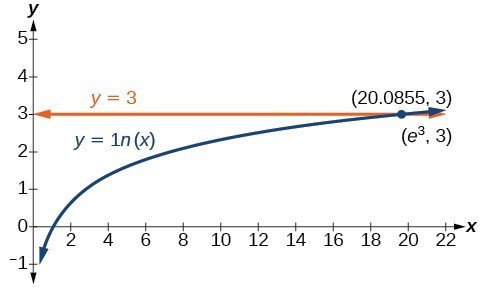171 Use the definition of a logarithm to solve logarithmic equations
We have already seen that every logarithmic equation [latex]{\mathrm{log}}_{b}\left(x\right)=y\\[/latex] is equivalent to the exponential equation [latex]{b}^{y}=x\\[/latex]. We can use this fact, along with the rules of logarithms, to solve logarithmic equations where the argument is an algebraic expression.
For example, consider the equation [latex]{\mathrm{log}}_{2}\left(2\right)+{\mathrm{log}}_{2}\left(3x - 5\right)=3\\[/latex]. To solve this equation, we can use rules of logarithms to rewrite the left side in compact form and then apply the definition of logs to solve for x:
A General Note: Using the Definition of a Logarithm to Solve Logarithmic Equations
For any algebraic expression S and real numbers b and c, where [latex]b>0,\text{ }b\ne 1\\[/latex],
Example 9: Using Algebra to Solve a Logarithmic Equation
Solve [latex]2\mathrm{ln}x+3=7\\[/latex].
Solution
[latex]\begin{cases}2\mathrm{ln}x+3=7\hfill & \hfill \\ \text{ }2\mathrm{ln}x=4\hfill & \text{Subtract 3}.\hfill \\ \text{ }\mathrm{ln}x=2\hfill & \text{Divide by 2}.\hfill \\ \text{ }x={e}^{2}\hfill & \text{Rewrite in exponential form}.\hfill \end{cases}\\[/latex]
Example 10: Using Algebra Before and After Using the Definition of the Natural Logarithm
Solve [latex]2\mathrm{ln}\left(6x\right)=7\\[/latex].
Solution
[latex]\begin{cases}2\mathrm{ln}\left(6x\right)=7\hfill & \hfill \\ \text{ }\mathrm{ln}\left(6x\right)=\frac{7}{2}\hfill & \text{Divide by 2}.\hfill \\ \text{ }6x={e}^{\left(\frac{7}{2}\right)}\hfill & \text{Use the definition of }\mathrm{ln}.\hfill \\ \text{ }x=\frac{1}{6}{e}^{\left(\frac{7}{2}\right)}\hfill & \text{Divide by 6}.\hfill \end{cases}\\[/latex]
Example 11: Using a Graph to Understand the Solution to a Logarithmic Equation
Solve [latex]\mathrm{ln}x=3\\[/latex].
Solution
[latex]\begin{cases}\mathrm{ln}x=3\hfill & \hfill \\ x={e}^{3}\hfill & \text{Use the definition of the natural logarithm}\text{.}\hfill \end{cases}\\[/latex]
Figure 2 represents the graph of the equation. On the graph, the x-coordinate of the point at which the two graphs intersect is close to 20. In other words [latex]{e}^{3}\approx 20\\[/latex]. A calculator gives a better approximation: [latex]{e}^{3}\approx 20.0855\\[/latex].

Try It 11
Use a graphing calculator to estimate the approximate solution to the logarithmic equation [latex]{2}^{x}=1000\\[/latex] to 2 decimal places.

